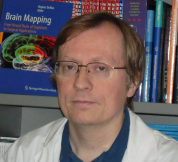
Hugues Duffau
Bio
Hugues DUFFAU (MD, PhD) is Professor and Chairman of the Neurosurgery Department in the Montpellier University Medical Center and Head of the INSERM 1191 Team « Plasticity of the central nervous system, human stem cells and glial tumors » at the Institute of Functional Genomics of Montpellier (France). He is an expert in the awake cognitive neurosurgery of slow-growing brain tumors, as low-grade gliomas, a routine which he has developed since more than twenty years. His fundamental approach is centered on the concepts of the brain connectomics and neuroplasticity, breaking with the traditional localizationist view of cerebral processing. For his innovative work in neurosurgery and neurosciences, he was awarded Doctor Honoris Causa six times, and he was the youngest recipient of the prestigious Herbert Olivecrona Award (Nobel Prize of neurosurgery) from the Karolinska Institute in Stockholm. He has written five textbooks and over 493 publications in international journals ranging from neurosurgery and neurooncology to fundamental neurosciences, including cognitive sciences and brain plasticity, for a total of more than 45,000 citations and with an h-index of 113. He gave more than 690 invited lectures, and was invited as a visiting professor in more than 60 institutions. He is member of Editorial boards of many journals (as Brain and Language, Neurosurgery or Neuro-oncology) and ad-hoc reviewer for around 100 journals (over 950 reviews) including: New England Journal of Medicine, Lancet Oncology, Nature Medicine, Nature Reviews Neuroscience, Nature Reviews Neurology; Annals of Neurology, Brain, Cerebral Cortex, Trends in Cognitive Science, Current Biology, etc. He is member of many societies, such as the French Academy of Medicine, the French Academy of Surgery, the Royal Academy of Medicine of Belgium, the World Academy of Neurological Surgery, the Young Neurosurgeons Award Committee of the World Federation of Neurosurgical Societies, the Scientific Committee of the European Association for Neurooncology, etc…
10 main publications:
. Duffau H. Lessons from brain mapping in surgery for low-grade glioma: insights into associations between tumour and brain plasticity. Lancet Neurol. 2005;4:476-86
. Duffau H, Gatignol P, Mandonnet E, Peruzzi P, Tzourio-Mazoyer N, Capelle L. New insights into the anatomo-functional connectivity of the semantic system: a study using cortico-subcortical electrostimulations. Brain. 2005;128:797-810.
. Thiebaut de Schotten M, Urbanski M, Duffau H, Volle E, Levy R, Dubois B, Bartolomeo P. Direct evidence for a parietal-frontal pathway subserving spatial awareness in humans. Science. 2005;309:2226-8
. De Witt Hamer PC, Robles SG, Zwinderman AH, Duffau H, Berger MS. Impact of intraoperative stimulation brain mapping on glioma surgery outcome: a meta-analysis. J Clin Oncol. 2012;30:2559-65
. Tate MC, Herbet G, Moritz-Gasser S, Tate JE, Duffau H. Probabilistic map of critical functional regions of the human cerebral cortex: Broca’s area revisited. Brain. 2014;137:2773-82
. Duffau H. Stimulation mapping of white matter tracts to study brain functional connectivity. Nat Rev Neurol. 2015;11:255-65
. Herbet G, Maheu M, Costi E, Lafargue G, Duffau H. Mapping neuroplastic potential in brain-damaged patients. Brain. 2016;139:829-44
. Rech F, Herbet G, Gaudeau Y, Mézières S, Moureau JM, Moritz-Gasser S, Duffau H. A probabilistic map of negative motor areas of the upper limb and face: a brain stimulation study. Brain. 2019;142:952-65.
. Herbet G, Duffau H. Revisiting the functional anatomy of the human brain: Toward a meta-networking theory of cerebral functions. Physiol Rev. 100:1181-1228, 2020
. Herbet G, Duffau H. Contribution of the medial eye field network to the voluntary deployment of visuospatial attention. Nat Commun. 2022;13(1):328
Abstract
Intraoperative connectomics and tumors: Towards a meta-networking organization of the human central nervous system
Prof. Hugues Duffau, MD, PhD
Department of Neurosurgery and INSERM U1191,
Gui de Chauliac Hospital, Montpellier University Medical Center, France
In the traditional literature, brain processing was mainly thought in a localisationist framework, in which one given function was sustained by a discrete cortical area, with a similar organization across individuals. However, this static view of cerebral functioning does not explain numerous observations of postlesional recovery. Here, the goal is to revisit this classical modular and inflexible model by evolving towards a dynamic organization of neural circuits, which enables adaptive phenomena. In addition to anatomic dissection in specimen, serial mappings performed in patients who underwent “connectome-based” awake surgery for low-grade glioma provided new insights into the brain anatomo-functional architecture. They evidenced a network distribution and resulted in the reappraisal of neural foundations underpinning movement, language, executive and emotional functions. Moreover, combination of neuropsychological assessments and functional neuroimaging before and after operation(s) demonstrated that massive resections of « critical » regions were feasible without eliciting permanent neurological deficits, thanks to neural reconfiguration mechanisms. These recent findings on brain connectome challenge the outdated localisationist view and lead to an alternative meta-networking theory, in which complex behaviors arise from the spatiotemporal integration of distributed cortico-subcortical networks subserving conation and cognition. Constant circuit interactions result in a perpetual succession of new neural equilibrium states, explaining interindividual behavioral variability and neuroplastic phenomena. A meta-networking organization underlies the uniquely human propensity to learn news abilities and also enables functional compensation in brain-damaged patients. The implications of this original neuroanatomical model are discussed in fundamental neurosciences as well as in clinical neuro-oncology, especially in surgery for low-grade glioma, with an optimization of both survival and quality of life.